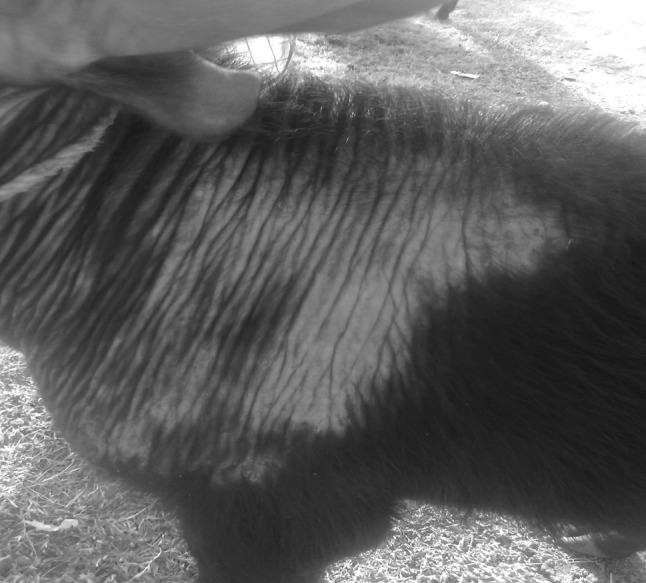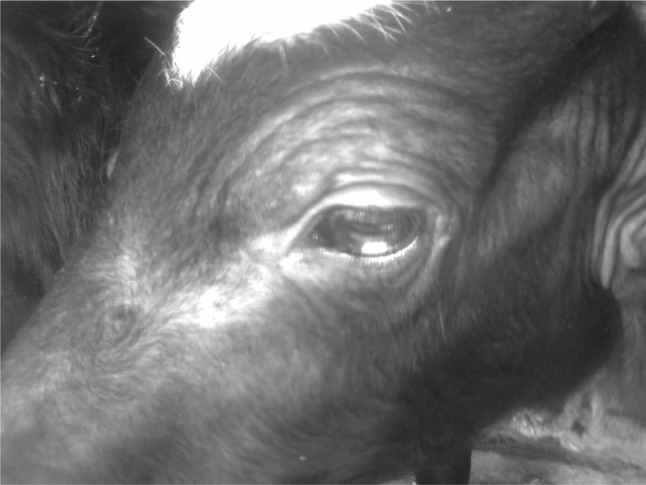Abstract
The efficacy of eprinomectin and ivermectin pour-on was evaluated against Sarcoptes scabiei in naturally infested buffaloes. Eighteen animals were allocated into three groups (A, B and C) of six animals each. Animals in group A were treated with eprinomectin (pour-on) @ 0.5 mg/kg; group B with ivermectin (pour-on) @ 0.2 mg/kg while group C served as untreated controls. Skin scrapings were examined on days 0, 7, 14, 21, 28 and 42 post-treatment (PT). Skin scrapings were found free for mites on day 21 PT, with marked clinical improvement in the lesions after day 28 of treatment. Untreated control group continued to show severe progressive lesions throughout the study period. No clinical side-effects of the tested drugs were observed after treatment. This preliminary report on the efficacy of eprinomectin (pour-on) against S. scabiei in buffaloes is encouraging and results could be of considerable importance.
Keywords: Buffaloes, Efficacy, Eprinomectin, Ivermectin, Sarcoptes scabiei
Introduction
Buffaloes have versatile roles in socio-economic improvement of the rural agricultural communities in south-east Asian countries. In the Indian subcontinent, dairy buffaloes are usually infested with several parasites, among which mite infestation caused by Sarcopties scabiei, is a common and serious problem (Tikaram and Ruprah 1986). The disease spreads rapidly in dairy and breeding herds in India with the morbidity rate varying from 1.5 to 82 %, reaching up to 100 % in severely affected herds, causing heavy losses of young animals (Gill et al. 1989). Close confinement and malnutrition in Indian dairy herds further aggravate the condition. In buffaloes, it causes poor body conditions, alopecia, keratinization, thickened and wrinkled skin, intense itching, excoriation and even death (Soulsby 1982; Tikaram and Ruprah 1986).
Control of mange on buffaloes can be achieved by application of topical chemical acaricides such as organophosphates and pyrethroids. However, burrowing habit of mites into the epidermis makes them difficult to control and sometimes two or more applications are necessary at 7–10 days intervals for effective cure (Chhabra and Pathak 2011). This is logistically impractical in overcrowded dairy herds in the Indian subcontinent. The avermectins have revolutionised our approach towards control of mange as well as internal parasites. Ivermectin injectable (Gill et al. 1989) and pour-on (Nazir et al. 2013a, b, c) has shown to be effective against endo- and ectoparasites in buffaloes. Eprinomectin, a second generation macrocyclic lactone produced from Streptomyces avermitilis has been shown to be highly effective against gastrointestinal nematodes (Gogolewski et al. 1997b) and ectoparasites (Barth et al. 1997; Eagleson et al. 1997; Aguirre et al. 2005) in cattle at a dose rate of 0.5 mg/kg, but there is no published report on its efficacy against S. scabiei infestation in buffaloes. Therefore, the present trial was conducted to determine the comparative efficacy of pour-on preparations of eprinomectin and ivermectin against natural infestation of S. scabiei in buffaloes at R.S. Pura, Jammu, India.
Materials and methods
Eighteen buffaloes of either sex, aged 1–6 years belonging to the local dairy units of village Chak-siyan of Jammu district and naturally infested with S. scabiei (having skin lesions on the neck, shoulder, forehead, ears, abdomen and back) were selected for the trial (Figs. 1 and 2). These animals were allocated into three groups (A, B and C) of six animals each. Animals in group A were treated with eprinomectin (pour-on) (Indian Immunologicals) @ 0.5 mg/kg, along the dorsal midline (from neck to wither) and group B was treated with ivermectin (pour-on) (Virbac Animal Health Ltd., India) @ 0.2 mg/kg body weight, while animals in group C were kept as untreated controls.
Fig. 1.

Lesions of mange on the neck region
Fig. 2.

Lesions of mange on face
The skin scrapings were collected from the edges of active lesions in wide-mouthed glass vials containing 10 % KOH on day 0, 7, 14, 21, 28 and 42 post-treatment (PT). These samples were brought to the laboratory and examined under stereomicroscope using standard techniques (Soulsby 1982). The number of mites was counted in skin scrapings taken from one square centimeter of the infested area. The animals were observed for the adverse effects of the drugs tested and the clinical improvement in the skin lesions throughout the study period. The data recorded were analysed by paired t test (Snedecor and Cochran 1967) and a p-value of <0.05 was considered significant.
Results and discussion
The results of the study are presented in Table 1. There was a progressive significant (p < 0.05) decrease in the number of mites (per cm2) after 7 days of treatment, and 76 % and 78.94 % reduction in the number of mites was observed in eprinomectin and ivermectin treated groups, respectively. The animals stopped rubbing of the body and were comfortable with the environment. Skin scrapings were free from the mite on day 21 PT. However, marked progressive improvement in the physical appearance of the lesions was evidenced only after day 28 of treatment. The keratinised lesions and cutaneous wrinkles were resolved completely. Regrowth of hair was observed after days 35 of treatment. Although ivermectin had a higher efficacy than eprinomectin on day 7 and 14 PT, the between group differences were not significant. No adverse reaction was observed in the experimental animals during or after the trial period, indicating that the tested drugs were well tolerated. Buffaloes of untreated control group were found positive for mites throughout the trial periods and had shown severe extensive lesions of sarcoptic mange. These animals were treated successfully with eprinomectin pour-on after the end of trial on day 42.
Table 1.
Efficacy of pour-on eprinomectin and ivermectin against S. scabiei in buffaloes
| Groups | Mite counts (per cm2) days post-treatment | |||||
|---|---|---|---|---|---|---|
| 0 | 7 | 14 | 21 | 28 | 42 | |
| A (n = 6) | 25 | 6* | 2* | 0* | 0* | 0* |
| (76 %) | (92 %) | (100 %) | (100 %) | (100 %) | ||
| B (n = 6) | 19 | 4* | 1* | 0* | 0* | 0* |
| (78.9 %) | (94.7 %) | (100 %) | (100 %) | (100 %) | ||
| C (n = 6) | 20 | 23 | 27 | 31 | 23 | 29 |
Figures in parenthesis indicates percent efficacy
* Significant (p < 0.05) decrease in live mite count from day 0 in the same row
Buffalo, popularly known as “Black Diamond”, has versatile role in socio-economic improvement of the rural agricultural communities in South-east Asian countries. In the Indian subcontinent, dairy buffaloes are usually infested with several parasites, among which mite infestations cause severe morbidity and mortality and heavy economic losses to dairy owners (Gill et al. 1989; Patel et al. 2002; Naresh et al. 2005; Nazir 2011). Sarcoptic mange in buffaloes is often neglected and the most of the buffalo owners believe that it is adequate merely to rub diluted acaricide over visibly affected areas but this is useless as an effective control measure for sarcoptic mange, and inadequate wetting of thick skin crusts in chronic cases protect the mites from acaricide solution. Further due to over stocking rate in dairy herds in India, the use of injectable preparations is neither advisable nor practicable.
The results of the study are in accordance with earlier reports on high efficacy of topical preparation of eprinomectin against gastrointestinal nematodes (Gogolewski et al. 1997b), lungworms (Wapennar et al. 2007), louse infestation (Eagleson et al. 1997), ticks (Aguirre et al. 2005) and mange-mites (Barth et al. 1997) in cattle, @ 0.5 mg/kg. The present study therefore appears to be the first report on the use of eprinomectin (pour-on) for control of S. scabiei in buffaloes. Although topical preparations of both eprinomectin and ivermectin have high efficacy against S. scabiei, eprinomectin has an edge over ivermectin, owing to its zero milk and meat withdrawal time (Alvinerie et al. 1999), and the efficacy is not affected by coat length, rain and weather (Gogolewski et al. 1997a).
In conclusion, this preliminary report on the efficacy of eprinomectin pour-on against S. scabiei in buffaloes is encouraging and results could be of considerable importance. The many difficulties implicit in the use of potentially toxic chemical sprays could be avoided and the control, particularly on a herd basis, of this troublesome disease could be revolutionised.
Acknowledgments
The authors are thankful to Indian Immunologicals for supplying eprinomectin pour-on for clinical trial.
References
- Aguirre DH, Gaido AB, Cafrune MM, Castelli ME, Mangold AJ, Guglielmone AA. Eprinomectin pour-on for control of Boophilus microplus (Canestrini) ticks (Acari: Ixodidae) on cattle. Vet Parasitol. 2005;127:157–163. doi: 10.1016/j.vetpar.2004.09.027. [DOI] [PubMed] [Google Scholar]
- Alvinerie M, Sutra JF, Galtier P, Mage C. Pharmacokinetics of eprinomectin in plasma and milk following topical administration to lactating dairy cattle. Res Vet Sci. 1999;67:229–232. doi: 10.1053/rvsc.1999.0312. [DOI] [PubMed] [Google Scholar]
- Barth D, Hair JA, Kunkle BN, Langholff WK, Lowenstein M, Rehbein S, Smith LL, Eagleson JS, Kutzer E. Efficacy of eprinomectin against mange-mites in cattle. Am J Vet Res. 1997;58:1257–1259. [PubMed] [Google Scholar]
- Chhabra MB, Pathak KLM. Sarcoptic mange in domestic animals and human scabies in India. J Vet Parasitol. 2011;25:1–10. [Google Scholar]
- Eagleson JS, Holste JE, Pollmeier M (1997) Efficacy of topically applied eprinomectin against the biting louse Damalinia (Bovicola) bovis. In: Proceedings of the 16th international conference of the world association for the advancement of veterinary parasitology, Aug, pp 10–15
- Gill BS, Singh J, Gill BS, Singh A, Khehra SS, Rai A, Hussain O. Efficacy of ivermectin against mange and gastrointestinal nematodes of buffalo (Bubalus bubalis) Vet Parasitol. 1989;31:141–147. doi: 10.1016/0304-4017(89)90029-0. [DOI] [PubMed] [Google Scholar]
- Gogolewski RP, Allerton GR, Pitt SR. Effect of simulated rain, coat length and exposure to natural climatic conditions on the efficacy of a topical formulation of eprinomectin against endoparasites of cattle. Vet Parasitol. 1997;69:95. doi: 10.1016/S0304-4017(96)01095-3. [DOI] [PubMed] [Google Scholar]
- Gogolewski RP, Slacek B, Familton AS. Efficacy of a topical formulation of eprinomectin against endoparasites of cattle in New Zealand. N Z Vet J. 1997;45:1. doi: 10.1080/00480169.1997.35978. [DOI] [PubMed] [Google Scholar]
- Naresh R, Swaroop D, Sharma MC, Ranjan R. Clinical management of sarcoptic mange in Indian buffalo calves with the botanical ointment. Vet Rec. 2005;156:684–685. doi: 10.1136/vr.156.21.684. [DOI] [PubMed] [Google Scholar]
- Nazir T (2011) Epidemiological and chemotherapeutic studies of parasites of buffaloes. M.V.Sc thesis, (submitted) Sher-e-Kashmir University of Agricultural Sciences and Technology, Jammu, India, pp 1–94
- Nazir T, Katoch R, Godara R, Yadav A, Borkataki S. Therapeutic efficacy of pour-on preparations of eprinomectin and ivermectin against strongylosis in buffaloes. Indian Vet J. 2013;90(1):112–113. [Google Scholar]
- Nazir T, Katoch R, Godara R, Yadav A. Comparative efficacy of pour-on preparations of eprinomectin and ivermectin against ascarids in buffalo calves. Indian Vet J. 2013;90(6):79–80. [Google Scholar]
- Nazir T, Katoch R, Godara R, Yadav A. Efficacy of eprinomectin pour-on against Rhipicephalus (Boophilus) microplus on buffaloes. J Parasit Dis. 2013;37:166–167. doi: 10.1007/s12639-012-0152-x. [DOI] [PMC free article] [PubMed] [Google Scholar]
- Patel JS, Patel PR, Panchasara HH. Economic losses due to sarcoptic mange in buffalo calves. Vet Pract. 2002;3:186–189. [Google Scholar]
- Snedecor GW, Cochran WG. Statistical methods. 6. New Delhi: Oxford and IBH Publishing Com; 1967. [Google Scholar]
- Soulsby EJL. Helminths, arthropods and protozoa of domesticated animals. 7. London, UK: ELBS and Bailliere Tindall; 1982. [Google Scholar]
- Tikaram SM, Ruprah NS. Incidence of sarcoptic mange in buffaloes in India. Trop Anim Health Prod. 1986;18:86–90. doi: 10.1007/BF02359718. [DOI] [PubMed] [Google Scholar]
- Wapennar W, Barkema HW, Fysker M, O’Handley RM. An outbreak of dictyocaulosis in lactating cows on a dairy farm. J Am Vet Med Assoc. 2007;231:1715–1718. doi: 10.2460/javma.231.11.1715. [DOI] [PubMed] [Google Scholar]


